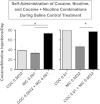Effects of chronic varenicline treatment on nicotine, cocaine, and concurrent nicotine+cocaine self-administration
- PMID: 24304823
- PMCID: PMC3957118
- DOI: 10.1038/npp.2013.325
Effects of chronic varenicline treatment on nicotine, cocaine, and concurrent nicotine+cocaine self-administration
Abstract
Nicotine dependence and cocaine abuse are major public health problems, and most cocaine abusers also smoke cigarettes. An ideal treatment medication would reduce both cigarette smoking and cocaine abuse. Varenicline is a clinically available, partial agonist at α4β2* and α6β2* nicotinic acetylcholine receptors (nAChRs) and a full agonist at α7 nAChRs. Varenicline facilitates smoking cessation in clinical studies and reduced nicotine self-administration, and substituted for the nicotine-discriminative stimulus in preclinical studies. The present study examined the effects of chronic varenicline treatment on self-administration of IV nicotine, IV cocaine, IV nicotine+cocaine combinations, and concurrent food-maintained responding by five cocaine- and nicotine-experienced adult rhesus monkeys (Macaca mulatta). Varenicline (0.004-0.04 mg/kg/h) was administered intravenously every 20 min for 23 h each day for 7-10 consecutive days. Each varenicline treatment was followed by saline-control treatment until food- and drug-maintained responding returned to baseline. During control treatment, nicotine+cocaine combinations maintained significantly higher levels of drug self-administration than nicotine or cocaine alone (P<0.05-0.001). Varenicline dose-dependently reduced responding maintained by nicotine alone (0.0032 mg/kg/inj) (P<0.05), and in combination with cocaine (0.0032 mg/kg/inj) (P<0.05) with no significant effects on food-maintained responding. However, varenicline did not significantly decrease self-administration of a low dose of nicotine (0.001 mg/kg), cocaine alone (0.0032 and 0.01 mg/kg/inj), or 0.01 mg/kg cocaine combined with the same doses of nicotine. We conclude that varenicline selectively attenuates the reinforcing effects of nicotine alone but not cocaine alone, and its effects on nicotine+cocaine combinations are dependent on the dose of cocaine.
Figures



Similar articles
-
Effects of varenicline on the reinforcing and discriminative stimulus effects of cocaine in rhesus monkeys.J Pharmacol Exp Ther. 2011 Nov;339(2):678-86. doi: 10.1124/jpet.111.185538. Epub 2011 Aug 19. J Pharmacol Exp Ther. 2011. PMID: 21856860 Free PMC article.
-
Effects of chronic buspirone treatment on nicotine and concurrent nicotine+cocaine self-administration.Neuropsychopharmacology. 2013 Jun;38(7):1264-75. doi: 10.1038/npp.2013.25. Epub 2013 Jan 21. Neuropsychopharmacology. 2013. PMID: 23337868 Free PMC article.
-
Pharmacologic characterization of a nicotine-discriminative stimulus in rhesus monkeys.J Pharmacol Exp Ther. 2012 Jun;341(3):840-9. doi: 10.1124/jpet.112.193078. Epub 2012 Mar 21. J Pharmacol Exp Ther. 2012. PMID: 22438471 Free PMC article.
-
The contribution of agonist and antagonist activities of α4β2* nAChR ligands to smoking cessation efficacy: a quantitative analysis of literature data.Psychopharmacology (Berl). 2018 Sep;235(9):2479-2505. doi: 10.1007/s00213-018-4921-9. Epub 2018 Jul 7. Psychopharmacology (Berl). 2018. PMID: 29980822 Review.
-
Hormones, nicotine, and cocaine: clinical studies.Horm Behav. 2010 Jun;58(1):57-71. doi: 10.1016/j.yhbeh.2009.10.003. Epub 2009 Oct 14. Horm Behav. 2010. PMID: 19835877 Free PMC article. Review.
Cited by
-
Enhancing translation: A need to leverage complex preclinical models of addictive drugs to accelerate substance use treatment options.Pharmacol Biochem Behav. 2024 Oct;243:173836. doi: 10.1016/j.pbb.2024.173836. Epub 2024 Jul 26. Pharmacol Biochem Behav. 2024. PMID: 39067531 Review.
-
Nicotine modifies cocaine responding in a concurrent self-administration model.Drug Alcohol Depend. 2023 Oct 1;251:110960. doi: 10.1016/j.drugalcdep.2023.110960. Epub 2023 Sep 7. Drug Alcohol Depend. 2023. PMID: 37703771 Free PMC article.
-
Discovery and development of varenicline for smoking cessation.Expert Opin Drug Discov. 2018 Jul;13(7):671-683. doi: 10.1080/17460441.2018.1458090. Epub 2018 Mar 28. Expert Opin Drug Discov. 2018. PMID: 29587555 Free PMC article. Review.
-
Varenicline decreases nicotine but not alcohol self-administration in genetically selected Marchigian Sardinian alcohol-preferring (msP) rats.Drug Alcohol Depend. 2015 Nov 1;156:126-132. doi: 10.1016/j.drugalcdep.2015.09.002. Epub 2015 Sep 8. Drug Alcohol Depend. 2015. PMID: 26383997 Free PMC article.
-
Varenicline and GZ-793A differentially decrease methamphetamine self-administration under a multiple schedule of reinforcement in rats.Behav Pharmacol. 2018 Feb;29(1):87-97. doi: 10.1097/FBP.0000000000000340. Behav Pharmacol. 2018. PMID: 28863003 Free PMC article.
References
-
- Andreoli M, Tessari M, Pilla M, Valerio E, Hagan JJ, Heidbreder CA. Selective antagonism at dopamine D3 receptors prevents nicotine-triggered relapse to nicotine-seeking behavior. Neuropsychopharmacology. 2003;28:1272–1280. - PubMed
-
- Budney AJ, Higgins ST, Hughes JR, Bickel WK. Nicotine and caffeine use in cocaine-dependent individuals. J Subst Abuse. 1993;5:117–130. - PubMed
Publication types
MeSH terms
Substances
Grants and funding
LinkOut - more resources
Full Text Sources
Other Literature Sources
Medical

